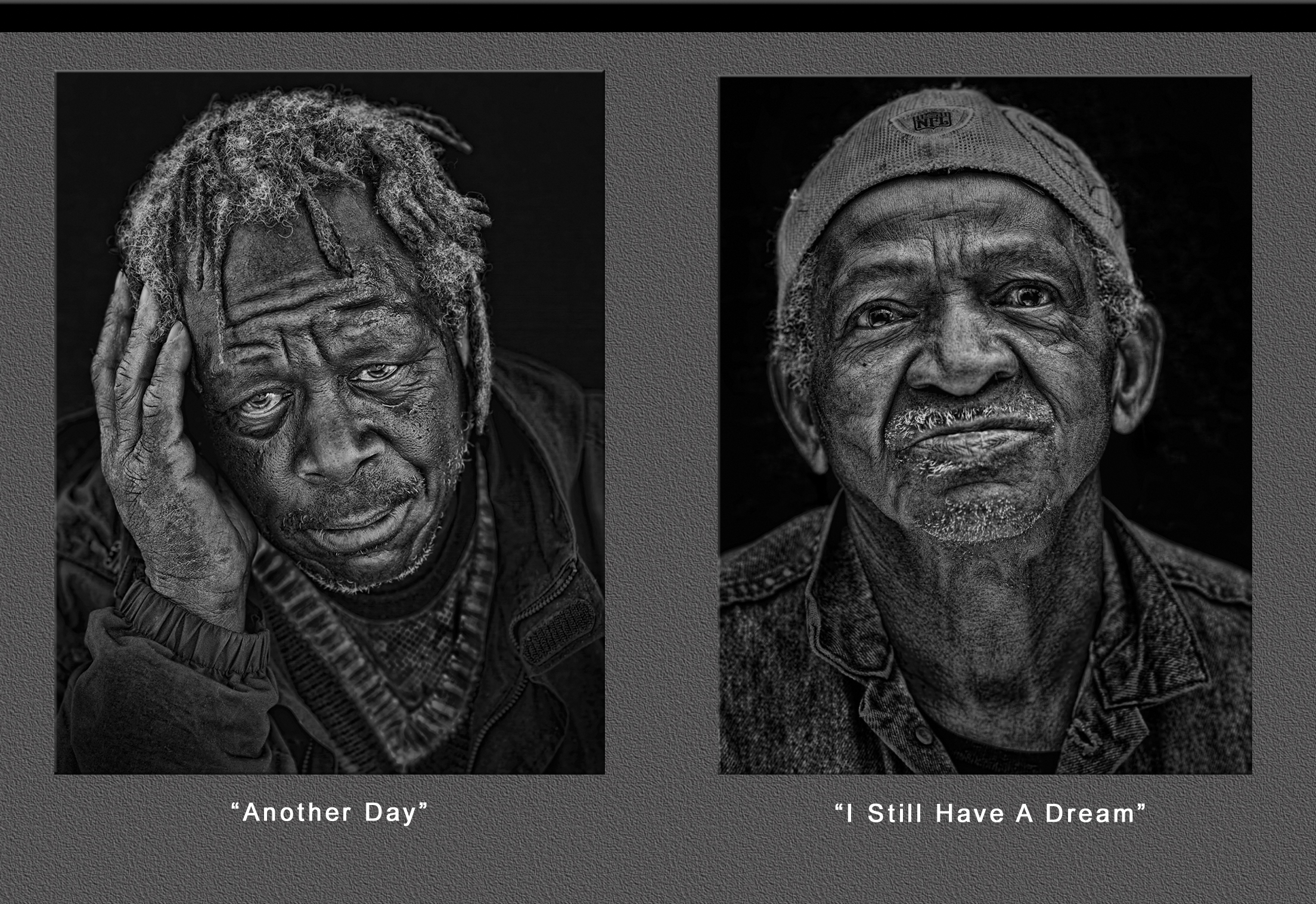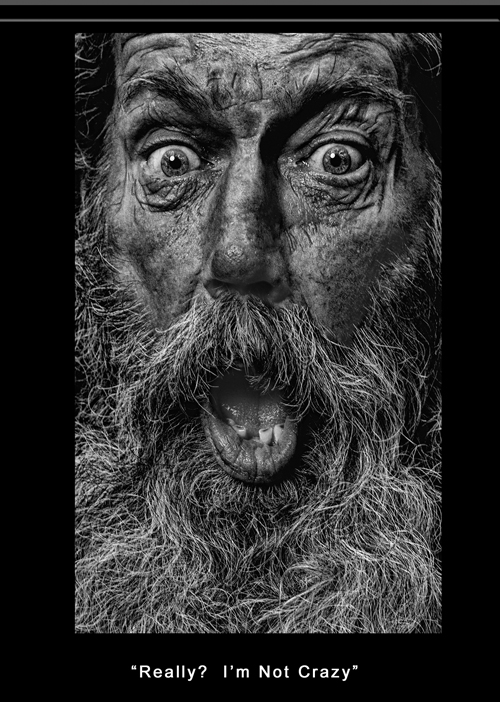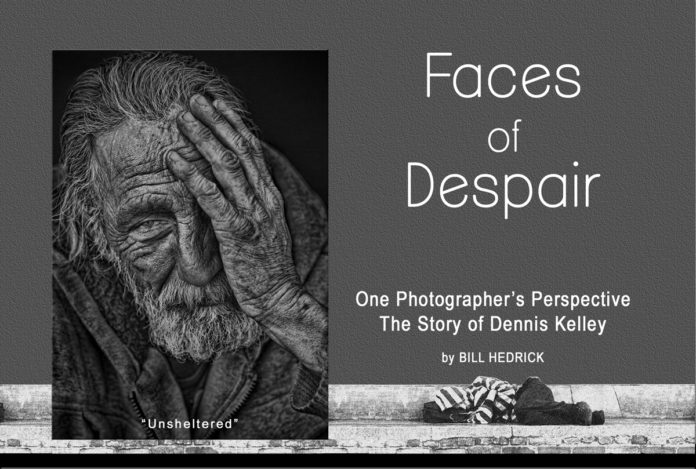A lot has been written over the centuries about human compassion. In its broadest terms, compassion is the ability to understand the emotional state of others as well as oneself. But it has the added element of having a desire to alleviate or reduce the suffering of another person. Even so, it is sometimes easy to simply ignore the plight of others rather than to become involved with things we fear or abhor.
Dennis Kelley’s previous career in law enforcement required him to be very focused and serious, but dealing with “street people,” many of whom are destitute and mentally ill, was a part of his job that he hated the most. At that time, he believed that all homeless individuals were homeless as a result of poor life choices. Like many other cops, Dennis felt as if dealing with these dirty and smelly people was far from rewarding. Little did he realize at the time how this experience would play a significant role in his new career as a professional photographer.
After 25 years in law enforcement, Dennis retired in January 2016. Unfortunately, he carried many of his attitudes about the homeless into retirement. But as time passed, he realized something that had happened to him throughout his career. He had become very detached and isolated from society; insensitive and apathetic with people and had allowed his career to take over his personal life. Then, about six months into retirement, something changed. While walking to one of his favorite Mexican restaurants in downtown San Antonio, Dennis noticed a homeless man sitting on a street corner. The man’s weathered face was an eye-opener for Dennis and, for the first time in his life, he saw pain in the face of the homeless. Dennis walked over and began talking with this stranger and, during the conversation, he noticed that the homeless man never begged or asked for anything. He explained that he was simply “trying to survive” life on the street and had nothing except the clothes on his back.
From that moment on, Dennis’s attitude about people on the streets continued to change with more and more observation and interaction. His aspiration to hear the life stories of the homeless grew into his street portrait project called, “Starving for Pennies.” The purpose was to evoke emotion by telling a photographic story of the impoverished, some by choice, some not by choice, and sharing the hurt, pain, and brokenness of others through the lens of a camera. But the project also became a personal healing process for Dennis as well.
Photographing “on the streets” is not for everyone and it takes a certain measure of talent and experience to make it work. It also requires a different way of thinking and those who are introverts will find this kind of photography especially challenging. “You have to force yourself to engage with people and be completely in the moment,” explains Dennis. “You must empathize with the subject to build trust and then listen carefully to what they have to say. They are not objects, so you need to treat them as emotional beings. Along the way, a lot of them will say ‘no’ but you must continue your journey. It is also important to put yourself in the subject’s position and ask how you might respond when being asked permission by a photographer. But remember, when you start showing your own vulnerabilities, the stranger will start to show their’s.”
Safety is another very important consideration. When Dennis hits the streets, he takes safety seriously and stresses that it is the most important aspect of street portraiture when interacting with strangers. He always takes an assistant along, not only to help with gear, but as an extra set of eyes while he is focused on his subject. Even so, Dennis will only approach individuals who are alone or in small groups and uses “gentle assertiveness” when approaching strangers. “I don’t just look for ‘any’ homeless person,” he explains. “I look for the ‘veteran’ homeless subject which will add impact to the storytelling.” Being honest and building rapport with the subject is an essential first step and Dennis will always introduce himself and explain why he wants to photograph the subject. He will also notice and study interesting characteristics of the subjects such as their eyes, facial hair, eyeglasses, etc. Then, he tells the individual what the images will be used for and always obtains a signed model release. A typical session will last from five to ten minutes.
Lighting is another important aspect of street photography and most of Dennis’s street portraits are created with the use of one or two reflectors, using silver panels for specular highlights accentuating facial wrinkles and creating specular reflections in the eyes. Depending on the lighting conditions, Dennis may also use a scrim or flag in controlling light. “I love to expose every wrinkle, scar, accumulated dirt, and every other element of an individual’s face in my efforts to tell their stories.”

The image “Unsheltered” is of a gentleman named Larry who was 61 years old and has always lived in San Antonio. Larry was living with his mother and their house burned. Without any insurance, they lost everything. A month after the fire, his mother passed away and, today, Larry lives near the Greyhound Bus Station in downtown San Antonio. The title was selected because Larry has no roof over his head and is homeless.
“Another Day” is a portrait of Johnny who is 63 years old and originally from Peoria, Illinois. Johnny has called the streets on the east side of San Antonio his home for many years. He went through a divorce, got in trouble with the law, and hitchhiked to San Antonio looking for work. Without the ability to keep a job, Johnny takes it day by day on the streets without any family or place to live. The title of the image was selected as Johnny’s response to how each day is just “Another Day.”
Other stories convey just a glimmer of hope in desperate times as with “I Still Have a Dream.” Mike was 60 years old and from Tulsa, Oklahoma. In 1998, he divorced and took a bus to San Antonio for a “fresh start.” Since that time, he has been unable to hold a steady job and admits he has commitment issues but remains positive about life. Mike has found his home to be under a bridge of a major interstate just east of downtown San Antonio. The title of the image was chosen because of Mike’s positive outlook on life despite the hardships of being homeless.
 Some titles are selected from direct quotes. James was a 64 year old homeless man living near the Scottish Rite Cathedral in downtown San Antonio. While Dennis was photographing him, James stated, “Really? I’m Not Crazy!” After talking with James for a few minutes, he explained to Dennis that he suffers from mental illness which has contributed to him becoming involved in many fist fights on the streets. “James had the knuckles to back up his story,” says Dennis.
Some titles are selected from direct quotes. James was a 64 year old homeless man living near the Scottish Rite Cathedral in downtown San Antonio. While Dennis was photographing him, James stated, “Really? I’m Not Crazy!” After talking with James for a few minutes, he explained to Dennis that he suffers from mental illness which has contributed to him becoming involved in many fist fights on the streets. “James had the knuckles to back up his story,” says Dennis.
Post-production of these images can sometimes take several hours to culminate in Dennis’s own style. Most of them are black and white. Using Adobe Photoshop, he often spends hours just “burning” the subject’s wrinkles and even fingernails, as well as making adjustments to any distracting elements commonly found on hats and shirts.
Cropping is also critical and can enhance the storytelling by eliminating any dead space that can kill a photo. “Always make sure shadows are not blocked up and that highlights are not blown out,” he adds. However, Dennis always strives to capture images in-camera with proper exposure and composition. But spending time in post-production represents his own style and helps portray a powerful story.
But even with all the experience and skill in the world, it is sometimes difficult to decide what story to tell. His advice is to choose something that you are deeply connected to and very passionate about. “We must ask ourselves why the story is relevant to others and how we will humanize it,” he explains. “However, we need to remember the Twelve Elements of Print Competition as well and use them as a guide when capturing portraits on the street.”
Dennis has come a long way since January of 2016, not only as a photographer but as a compassionate human being with a growing awareness of the world around him. With camera in hand, he continues to do his part to call attention to the less fortunate among us. Like other professionals over the years, Dennis Kelley has discovered that photography is a lot more than just taking pictures.
 Dennis Kelley, is an award-winning photographer from San Antonio, Texas, recognized nationally for his street portrait work. While serving in law enforcement, did photography as a hobby. After a 25 year career, he decided to retire and pursue photography as a professional. His work has been accepted into the prestigious PPA Loan Collection and he has been awarded PPA Gold Photographer of the Year. He currently serves as Vice-President of the Professional Photographers of San Antonio and will be one of the “Texas 10” speakers, hosting the event on March 25 in San Antonio.
Dennis Kelley, is an award-winning photographer from San Antonio, Texas, recognized nationally for his street portrait work. While serving in law enforcement, did photography as a hobby. After a 25 year career, he decided to retire and pursue photography as a professional. His work has been accepted into the prestigious PPA Loan Collection and he has been awarded PPA Gold Photographer of the Year. He currently serves as Vice-President of the Professional Photographers of San Antonio and will be one of the “Texas 10” speakers, hosting the event on March 25 in San Antonio.











